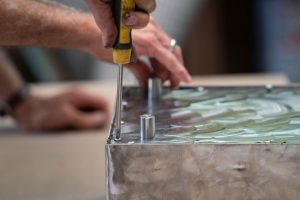
Governor Ralph Northam recently announced the artifacts for the new time capsule, crafted by Richmond sculptor Paul DiPasquale. The capsule will be placed in the concrete pedestal of Richmond’s Lee Monument.
Historians believe a copper time capsule was placed in the cornerstone of the Lee pedestal on October 27, 1887. Records from the Library of Virginia suggest that 37 Richmond residents, organizations, and businesses contributed about 60 objects to the capsule, many of which are believed to be related to the Confederacy.
Recently, the original time capsule will be removed and handed over to the Department of Historic Resources. This new time capsule will be put in its place in the statue’s base, as that will remain for the time being. Should it be removed later, the time capsule will be buried nearby.
“This monument and its time capsule reflected Virginia in 1890—and it’s time to remove both, so that our public spaces better reflect who we are as a people in 2021,” said Governor Northam. “The past 18 months have seen historic change, from the pandemic to protests for racial justice that led to the removal of these monuments to a lost cause. It is fitting that we replace the old time capsule with a new one that tells that story.”
The new capsule was crafted by Paul DiPasquale who also created Richmond’s Arthur Ashe monument and Virginia Beach’s King Neptune statue.
“The 1887 capsule we will remove this week offers us an incisive bite of time when the Lee Monument was erected. Now in 2021, this capsule gives future Virginians artifacts of the tectonic transition that has happened to us,” said DiPasquale. “The pedestal marks the past and has a new message for the future: we, all of us, are the New Virginia.”
Artifacts for the new time capsule were suggested by members of the public, and narrowed down to 39 final choices by a committee that included historians from the Richmond region’s leading historical and cultural museums and members of Governor Northam’s cabinet. The committee included:
- Heather Anderson, Community Engagement Coordinator at Black History Museum and Cultural Center of Virginia
- Alaysia Black Hackett, Deputy Chief Diversity Officer
- Jamie Bosket, Chief Executive Officer of the Virginia Museum of History & Culture
- Christy Coleman, Executive Director of Jamestown Yorktown Foundation
- Rita Davis, Former Counsel to the Governor
- Grindly Johnson, Secretary of Administration
- Julie Langan, Director of the Department of Historic Resources
- Bill Martin, Director of The Valentine
- Jennifer McClellan, Senate of Virginia, District 9
- Pamela Northam, First Lady of Virginia
- Alex Nyerges, Director and Chief Executive Officer of the Virginia Museum of Fine Arts
- Atif Qarni, Secretary of Education
- Scott Stroh, Executive Director of Gunston Hall
- Andrew Talkov, Senior Director of Curatorial Affairs at the Virginia Museum of History & Culture
- Sandra Treadway, Librarian of Virginia
- Janice Underwood, Chief Diversity Officer
The 39 artifacts are intended to reflect the cultural moment in Virginia’s, and the nation’s, history. In the past year and a half, Virginia has faced a global pandemic and a deep reckoning with racism. Protests for racial justice, sparked by the death of George Floyd, led to the removal of statues originally placed to memorialize those who fought to continue a way of life that enslaved other human beings. The artifacts are a snapshot of that moment in time, capturing both the protests of last year and the pandemic. They include a vaccination card, a photo of a Black ballerina in front of the statue, a Black Lives Matter sticker, a face mask, and a poem written in Unified English Braille.
“In the midst of demonstrations and reclaiming space, my photo of Black ballerina at America’s largest Confederate statue made national headlines in June 2020, surprising and inspiring viewers,” said photographer Marcus Ingram, whose photo will be included in the time capsule. “I am thrilled to have my print, my piece of history, be included in the new time capsule that aims to represent the Virginia of today. I am hopeful that future generations will see my photograph and understand what we stood up for.”




